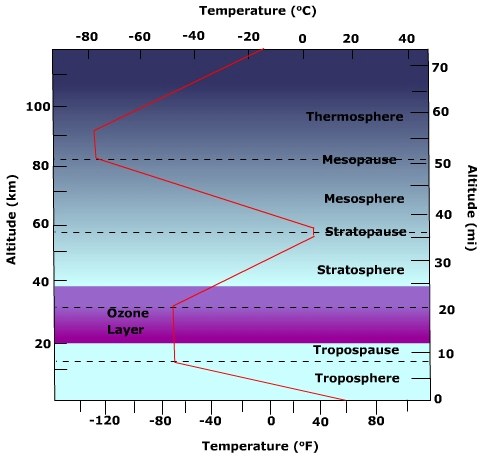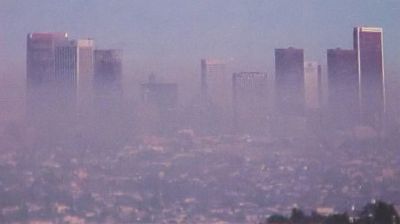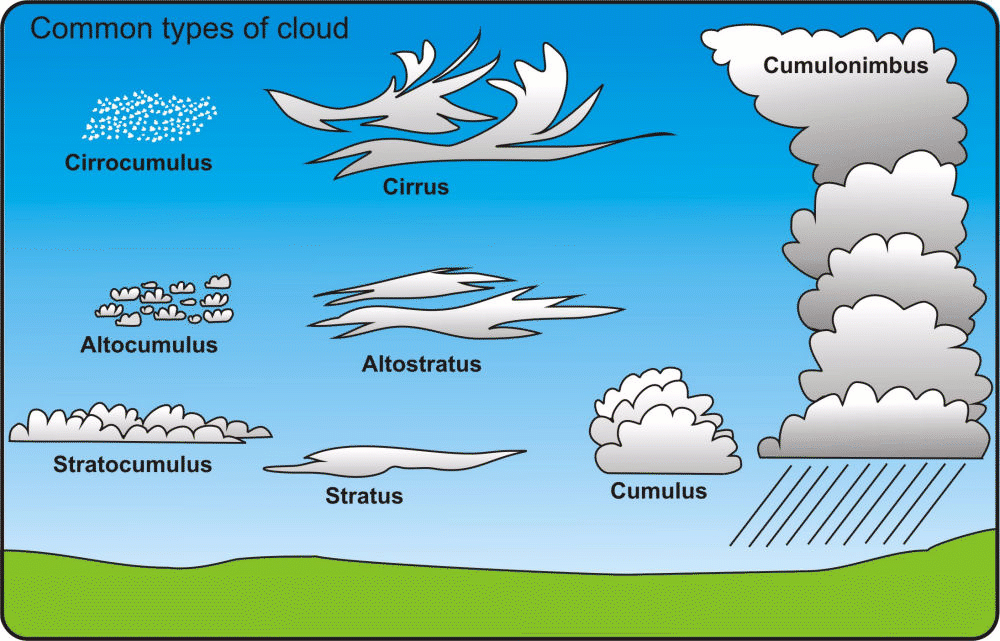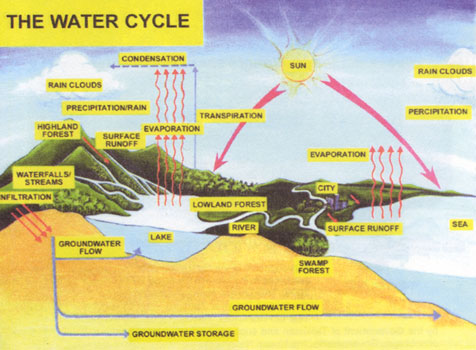| Home | Physics | Chemistry | Earth Science | Biology |
Earth's Atmosphere
You probably never think about the air you breathe. Your body uses only the oxygen in the air. But, oxygen is only one part of air. Earthís atmosphere is a mixture of gases. It consists of about 78 percent nitrogen, 21 percent oxygen, and smaller amounts of argon and water vapor. Trace gases make up a very small part of the atmosphere. Trace gases include carbon dioxide, methane, nitrous oxide, and ozone.
Respiration in the cells of organisms produces trace gases, such as water vapor and carbon dioxide. These gases are released into the air. During photosynthesis, certain organisms take carbon dioxide out of the air and release oxygen into it. Organisms produce nearly all of the atmospheric oxygen.
Microorganisms in swamps and soil release nitrogen and methane. Microorganisms in the digestive tracts of animals, such as termites and cows, also release methane.
Earthís early atmosphere contained mostly hydrogen and helium. These gases were lost and were replaced by volcanic gases, such as carbon dioxide and water vapor. Photosynthetic organisms in the oceans released oxygen into the atmosphere. Over time, the oxygen built up.
Intense radiation from the Sun changed some of the oxygen into ozone. The ozone accumulated in the upper atmosphere. The ozone layer protected Earth from some of the Sunís harmful ultraviolet rays. This allowed photosynthetic organisms to grow on land, so more oxygen was released into the atmosphere.
It took many millions of years for Earthís atmosphere to reach its current state. There is a delicate balance between processes that produce gases and processes that destroy them. However, humans may be upsetting this balance.
Earthís atmosphere extends more than 1,000 km above Earthís surface as shown in the figure below. Most of the atmosphere lies within 30 km of the surface in a region called the troposphere. The troposphere is the layer of the atmosphere in which most of the weather takes place. In the troposphere the temperatures normally decrease with height.
Sometimes, the temperature increases with height. A temperature inversion is an event that occurs near the ground when air temperature increases with height. When this happens, the air is very stable. The air resists the rising motion that is needed to form clouds or to scatter pollution.
The stratosphere is the layer above the trophosphere. It is extremely dry and rich in ozone. In this layer, the temperature increases with height. This creates a permanent inversion. The inversion begins at a place called the trophopause. It acts like a lid that keeps the trophosphere from rising into the stratosphere. The upper layers of the atmosphere are so thin that they do not take part in the weather.

The Sunís energy heats Earthís atmosphere. High above Earth in the stratosphere, solar radiation is intense. The solar radiation splits oxygen molecules into single atoms. These oxygen atoms then recombine to form ozone. Ozone absorbs nearly all the Sunís ultraviolet (UV) rays. This absorption by ozone is why temperature increases with height in the stratosphere.
The rest of the solar rays pass through the atmosphere to Earthís surface. Earth absorbs some solar radiation and reflects some back to the atmosphere. The heated surface of Earth gives off long-wave infrared radiation. Long wavelengths are absorbed by trace gases, especially carbon dioxide and water vapor. The greenhouse effect is the absorbing of long-wavelength radiation by trace gases and the re-emitting of infrared radiation back to Earthís surface. The greenhouse effect keeps Earth warm by absorbing heat and trapping it near the surface.
The atmosphereís most abundant gases are nitrogen and oxygen. They absorb little radiation and so do not add much heat to atmosphere. On the other hand, water vapor and carbon dioxide are strong absorbers of radiation. Although they make up very little of the atmosphere, they heat the atmosphere the most.
Earthís surface also heats the atmosphere through conduction, convection, and latent heat. Latent heat is the energy released or absorbed during the phase changes of water, such as evaporating water or melting snow. Latent heat energy is released into the atmosphere when water vapor condenses as clouds.
Because Earthís surface is extremely varied, it heats the atmosphere unevenly. Snow, ice, water, plant cover, and bare soil reflect different amounts of solar radiation back to space. They heat at different rates when they absorb solar radiation. For example, dry land absorbs heat rapidly and emits much radiation to the atmosphere. In contrast, water heats slowly and stores heat longer. This uneven surface heating causes pressure differences and wind.
Uneven heating has another effect. It creates air currents that carry water vapor aloft and form clouds. Air generally rises over warm surfaces and sinks over cold surfaces. Many birds and hang gliders soar on these warm rising air currents called thermals.
As air rises, it expands and cools. To form clouds, moist air must rise high enough to cool to its dew point. At this temperature, air is saturated and water vapor condenses to form cloud droplets. Small particles in the air, called condensation nuclei, trigger this process. Sometimes there are a lot of these nuclei in the air, such as dust or air pollution. When there are a lot of nuclei present, they can cause condensation even when the air is not saturated. This is how smog forms.

The formation of clouds is the first step in the process of precipitation. Precipitation is the term for moisture that falls from clouds as rain, hail, or snow. Different types of clouds are shown in the figure below. Two main types of clouds bring precipitation. These are the puffy cumulus type and the flat, long stratus type.
Cumulus clouds form from rising air parcels. Cumulus clouds may produce brief rain showers. Stratus clouds form mainly when layers of air rise gently. Stratus clouds produce drizzle or a long, steady rain. Many in-between types of clouds may form depending on how stable the air is and how high the clouds are in the atmosphere.
You have probably seen many types of clouds, including the cumulonimbus, or thunder clouds. Cumulonimbus clouds form in unstable air and usually bring heavy rain or thunderstorms.

Water droplets in clouds are usually so small that they are kept in the air by air currents. At times, they evaporate before they reach Earth. For precipitation to occur, the droplets must grow large. Droplets that grow when they collide and combine is called warm rain. Faster growth occurs when water droplets combine with ice crystals high in the atmosphere. This process is called cold rain.
The global water cycle, shown below, includes the processes of precipitation, runoff of water from the land, storage of groundwater, and evaporation. Plants play an important part in the water cycle. They affect how much water the soil absorbs and how much water runs off the land. Plants also return water to the air. They do this through the processes of transpiration and evaporation from their leaves.

People affect the water cycle in many ways. Humans pump groundwater for drinking or irrigation. They cut down forests and plant fields of crops. They drain swamps, pave land, build cities, and turn deserts into golf courses. Many of these activities have reduced water quality and water resources. Careful planning is needed to preserve Earthís water resources.